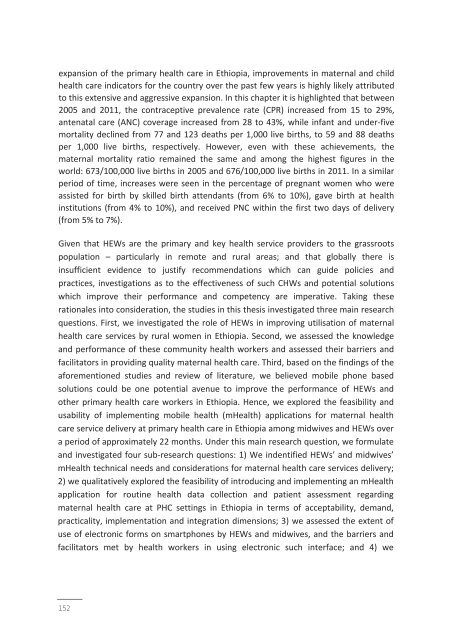araya-thesis
araya-thesis
araya-thesis
Create successful ePaper yourself
Turn your PDF publications into a flip-book with our unique Google optimized e-Paper software.
expansion of the primary health care in Ethiopia, improvements in maternal and child<br />
health care indicators for the country over the past few years is highly likely attributed<br />
to this extensive and aggressive expansion. In this chapter it is highlighted that between<br />
2005 and 2011, the contraceptive prevalence rate (CPR) increased from 15 to 29%,<br />
antenatal care (ANC) coverage increased from 28 to 43%, while infant and under‐five<br />
mortality declined from 77 and 123 deaths per 1,000 live births, to 59 and 88 deaths<br />
per 1,000 live births, respectively. However, even with these achievements, the<br />
maternal mortality ratio remained the same and among the highest figures in the<br />
world: 673/100,000 live births in 2005 and 676/100,000 live births in 2011. In a similar<br />
period of time, increases were seen in the percentage of pregnant women who were<br />
assisted for birth by skilled birth attendants (from 6% to 10%), gave birth at health<br />
institutions (from 4% to 10%), and received PNC within the first two days of delivery<br />
(from 5% to 7%).<br />
Given that HEWs are the primary and key health service providers to the grassroots<br />
population – particularly in remote and rural areas; and that globally there is<br />
insufficient evidence to justify recommendations which can guide policies and<br />
practices, investigations as to the effectiveness of such CHWs and potential solutions<br />
which improve their performance and competency are imperative. Taking these<br />
rationales into consideration, the studies in this <strong>thesis</strong> investigated three main research<br />
questions. First, we investigated the role of HEWs in improving utilisation of maternal<br />
health care services by rural women in Ethiopia. Second, we assessed the knowledge<br />
and performance of these community health workers and assessed their barriers and<br />
facilitators in providing quality maternal health care. Third, based on the findings of the<br />
aforementioned studies and review of literature, we believed mobile phone based<br />
solutions could be one potential avenue to improve the performance of HEWs and<br />
other primary health care workers in Ethiopia. Hence, we explored the feasibility and<br />
usability of implementing mobile health (mHealth) applications for maternal health<br />
care service delivery at primary health care in Ethiopia among midwives and HEWs over<br />
a period of approximately 22 months. Under this main research question, we formulate<br />
and investigated four sub‐research questions: 1) We indentified HEWs’ and midwives’<br />
mHealth technical needs and considerations for maternal health care services delivery;<br />
2) we qualitatively explored the feasibility of introducing and implementing an mHealth<br />
application for routine health data collection and patient assessment regarding<br />
maternal health care at PHC settings in Ethiopia in terms of acceptability, demand,<br />
practicality, implementation and integration dimensions; 3) we assessed the extent of<br />
use of electronic forms on smartphones by HEWs and midwives, and the barriers and<br />
facilitators met by health workers in using electronic such interface; and 4) we<br />
152


